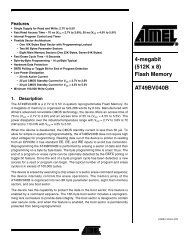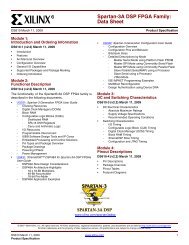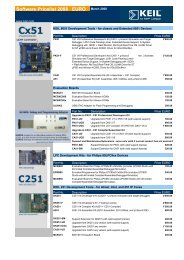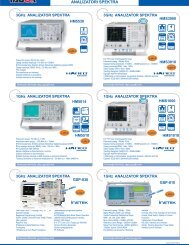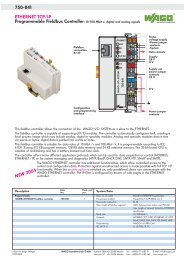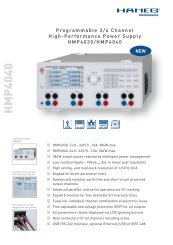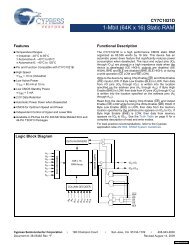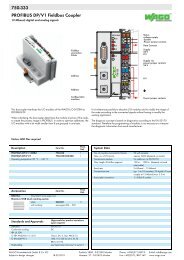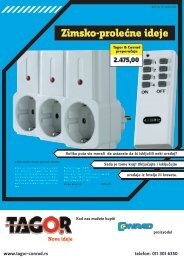PIC12F683 Data Sheet - Microchip
PIC12F683 Data Sheet - Microchip
PIC12F683 Data Sheet - Microchip
Create successful ePaper yourself
Turn your PDF publications into a flip-book with our unique Google optimized e-Paper software.
<strong>PIC12F683</strong><br />
4.2.4 ULTRA LOW-POWER WAKE-UP<br />
The Ultra Low-Power Wake-up (ULPWU) on GP0<br />
allows a slow falling voltage to generate an interrupt-on-change<br />
on GP0 without excess current consumption.<br />
The mode is selected by setting the<br />
ULPWUE bit of the PCON register. This enables a<br />
small current sink which can be used to discharge a<br />
capacitor on GP0.<br />
To use this feature, the GP0 pin is configured to output<br />
‘1’ to charge the capacitor, interrupt-on-change for GP0<br />
is enabled and GP0 is configured as an input. The ULP-<br />
WUE bit is set to begin the discharge and a SLEEP<br />
instruction is performed. When the voltage on GP0<br />
drops below VIL, an interrupt will be generated which will<br />
cause the device to wake-up. Depending on the state of<br />
the GIE bit of the INTCON register, the device will either<br />
jump to the interrupt vector (0004h) or execute the next<br />
instruction when the interrupt event occurs. See<br />
Section 4.2.3 “Interrupt-on-Change” and<br />
Section 12.4.3 “GPIO Interrupt” for more information.<br />
This feature provides a low-power technique for periodically<br />
waking up the device from Sleep. The time-out is<br />
dependent on the discharge time of the RC circuit<br />
on GP0. See Example 4-2 for initializing the Ultra<br />
Low-Power Wake-up module.<br />
The series resistor provides overcurrent protection for<br />
the GP0 pin and can allow for software calibration of the<br />
time-out (see Figure 4-1). A timer can be used to measure<br />
the charge time and discharge time of the capacitor.<br />
The charge time can then be adjusted to provide the<br />
desired interrupt delay. This technique will compensate<br />
for the affects of temperature, voltage and component<br />
accuracy. The Ultra Low-Power Wake-up peripheral<br />
can also be configured as a simple Programmable<br />
Low-Voltage Detect or temperature sensor.<br />
Note:<br />
EXAMPLE 4-2:<br />
For more information, refer to the Application<br />
Note AN879, “Using the <strong>Microchip</strong><br />
Ultra Low-Power Wake-up Module”<br />
(DS00879).<br />
ULTRA LOW-POWER<br />
WAKE-UP INITIALIZATION<br />
BANKSEL CMCON0 ;<br />
MOVLW H’7’ ;Turn off<br />
MOVWF CMCON0 ;comparators<br />
BANKSEL ANSEL ;<br />
BCF ANSEL,0 ;RA0 to digital I/O<br />
BCF TRISA,0 ;Output high to<br />
BANKSEL PORTA ;<br />
BSF PORTA,0 ;charge capacitor<br />
CALL CapDelay ;<br />
BANKSEL PCON ;<br />
BSF PCON,ULPWUE ;Enable ULP Wake-up<br />
BSF IOCA,0 ;Select RA0 IOC<br />
BSF TRISA,0 ;RA0 to input<br />
MOVLW B’10001000’ ;Enable interrupt<br />
MOVWF INTCON ; and clear flag<br />
SLEEP<br />
;Wait for IOC<br />
NOP ;<br />
© 2007 <strong>Microchip</strong> Technology Inc. DS41211D-page 35



